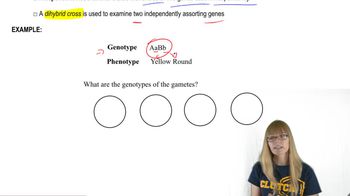Table of contents
- 1. Introduction to Genetics51m
- 2. Mendel's Laws of Inheritance3h 37m
- 3. Extensions to Mendelian Inheritance2h 41m
- 4. Genetic Mapping and Linkage2h 28m
- 5. Genetics of Bacteria and Viruses1h 21m
- 6. Chromosomal Variation1h 48m
- 7. DNA and Chromosome Structure56m
- 8. DNA Replication1h 10m
- 9. Mitosis and Meiosis1h 34m
- 10. Transcription1h 0m
- 11. Translation58m
- 12. Gene Regulation in Prokaryotes1h 19m
- 13. Gene Regulation in Eukaryotes44m
- 14. Genetic Control of Development44m
- 15. Genomes and Genomics1h 50m
- 16. Transposable Elements47m
- 17. Mutation, Repair, and Recombination1h 6m
- 18. Molecular Genetic Tools19m
- 19. Cancer Genetics29m
- 20. Quantitative Genetics1h 26m
- 21. Population Genetics50m
- 22. Evolutionary Genetics29m
3. Extensions to Mendelian Inheritance
Understanding Independent Assortment
Problem 33e
Textbook Question
An organism having the genotype AaBbCcDdEe is self-fertilized. Assuming the five genes assort independently, determine the following proportions:
progeny that are expected to have a phenotype identical to that of the parent
 Verified step by step guidance
Verified step by step guidance1
<span>Step 1: Identify the phenotype of the parent organism. The parent has the genotype AaBbCcDdEe, which means it is heterozygous for all five genes. Assuming complete dominance, the phenotype will be determined by the dominant alleles A, B, C, D, and E.</span>
<span>Step 2: Determine the probability of each offspring inheriting the same dominant phenotype for each gene. For a heterozygous pair (e.g., Aa), the probability of inheriting the dominant phenotype (A) is 3/4, as the possible genotypes are AA, Aa, and aa, with AA and Aa showing the dominant phenotype.</span>
<span>Step 3: Calculate the probability of an offspring having the same phenotype as the parent for all five genes. Since the genes assort independently, multiply the probabilities for each gene: (3/4) for A, (3/4) for B, (3/4) for C, (3/4) for D, and (3/4) for E.</span>
<span>Step 4: Use the multiplication rule of probability to find the overall probability: (3/4) * (3/4) * (3/4) * (3/4) * (3/4).</span>
<span>Step 5: Interpret the result as the proportion of progeny expected to have a phenotype identical to that of the parent.</span>
Recommended similar problem, with video answer:
 Verified Solution
Verified SolutionThis video solution was recommended by our tutors as helpful for the problem above
Video duration:
3mPlay a video:
Was this helpful?
Key Concepts
Here are the essential concepts you must grasp in order to answer the question correctly.
Independent Assortment
Independent assortment is a fundamental principle of genetics stating that alleles for different genes segregate independently of one another during gamete formation. This means that the inheritance of one trait will not affect the inheritance of another, allowing for a variety of combinations in the offspring's genotype.
Recommended video:
Guided course

Gamete Genetics and Independent Assortment
Genotype and Phenotype
The genotype refers to the genetic makeup of an organism, represented by the alleles it possesses, while the phenotype is the observable expression of those genes, influenced by both genotype and environmental factors. In this case, the phenotype identical to the parent would require the offspring to inherit the same combination of alleles as the parent.
Recommended video:
Guided course

Gamete Genotypes
Punnett Square
A Punnett square is a diagram used to predict the genetic outcomes of a cross between two organisms. By laying out the possible gametes from each parent, it allows for the visualization of potential genotypes and phenotypes in the offspring, making it a useful tool for calculating proportions of traits in progeny.
Recommended video:
Guided course

Chi Square Analysis

 4:58m
4:58mWatch next
Master Gamete Genetics and Independent Assortment with a bite sized video explanation from Kylia Goodner
Start learningRelated Videos
Related Practice

